The Blind Bard of Belfast: Carl Gilbert Hardebeck (1869-1945)
Published in 18th–19th - Century History, Features, Issue 3 (Autumn 1998), Volume 6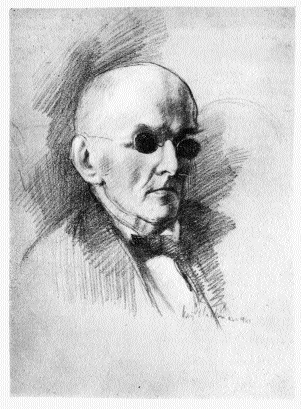
Carl GIlbert Hardebeck. Drawing by Seán O’Sullivan RHA. (Capuchin Annual)
In some humble céili house in the west of Ireland long ago the musician put his fiddle down to give the dancers a rest. It was time for the ‘singer of the household’ to take the floor, drawing from oral tradition sustained down the centuries in elemental form by echoes of ancestral voices. An itinerant bard honouring a festive occasion might carry away in his head some new melody, adding cadences of his own, to be rendered at a gathering in the next parish.
Pioneer collectors
An awareness of tradition on a national scale had to await the arrival of Edward Bunting, followed by George Petrie, Patrick Weston Joyce and others, who travelled the highways and byways of Ireland recording the folksong traditions of the countryside. These Irish pioneers were part of a movement that swept Europe towards the end of the eighteenth century. On the Continent improvements in communications facilitating easier travel and the spread of literacy combined to weaken the influence of local culture.
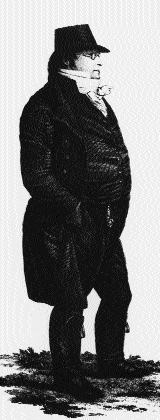
Edward Bunting c. 1811-one of the pioneer collectors.
…
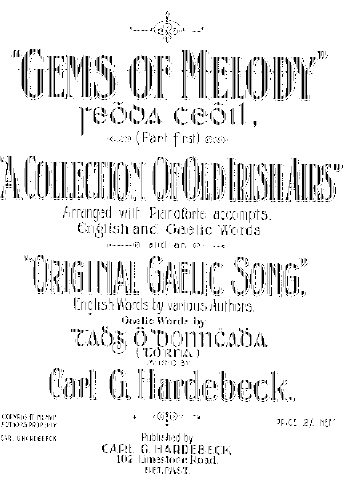
‘We must go to the peasants, visit them in their thatched huts’, the Polish writer, Adam Czarnocki, wrote in 1818, ‘take part in their feasts, work and amusements. In the smoke rising above their heads the ancient rites are still echoing, the old songs are still heard.’ Motivated initially by a reaction against artistic elitism and ‘artificiality’ in conventional art, the collectors also contributed to the rise of nationalism in its search for a definition of identity and liberation from foreign domination. There was no more potent way of achieving political ends than by rousing ordinary people through their ancient poetry and song.
The pioneers made initial mistakes. As Peter Burke has written: ‘The music had to be written down, since there was no other way of preserving it, and written down according to a system of conventions which were not made for music of this kind’. It is astonishing that the blind Irish collector, Carl Gilbert Hardebeck, questing in County Donegal, succeeded in overcoming his handicap.
‘Prerogative of the sightless’
Historically, as Vincent O’Brien reflected, ‘the blind harper, the blind piper and blind composer have been so linked with labours in the service of our song that one could easily believe that national musical activity was even a prerogative of the sightless’. Turlough Carolan was honoured in his day. An ‘able Irish scholar’ from County Clare, Patrick Lynch, tramping the roads of County Mayo at the turn of the nineteenth century on behalf of Edward Bunting met a blind piper in Louisburg. ‘I took down six good songs from the blind man,’ he wrote to Mary M’Cracken. ‘I never found anyone who had so great a variety of good old songs and tunes…He sings wells, and has a great memory; in short, he would be more useful to Mr Bunting than any man in Connaught.’
Lynch was ‘very attentive, very zealous, and very diligent’ in noting the words with the music of 200 songs, while other collectors without knowledge of the language had to be content writing down the melodies. To later generations the music in its own right seemed ‘to bewail all the woes of Ireland in old times’. The new lyrics were ‘nearly all of love, sometimes intense and plaintive, sometimes merely passionate’.
Honouring Hardebeck
The history of Irish traditional music was enriched when the editors of The Capuchin Annual, half-a-century ago, invited a symposium of musicians and scholars to pay tribute to Hardebeck. For what we know of his life and times we are indebted primarily to his close friends, Seán Neeson, sometime lecturer in Irish music in University College Cork, and Seán O’Boyle, musician and Gaelic scholar, St Patrick’s College, Armagh; Aloys Fleischmann, John F. Larchet, Vincent O’Brien, and to Michael Bowles, then director of music in Radio Éireann.
When Hardebeck was making the rounds of the Christian Brothers’ schools in Belfast in the years before the Great War, he fostered among a generation of boys in the northern capital a love for their heritage of Irish music and song. Neeson recalled Hardebeck’s ‘huge, Johnsonian bulk’ entering a classroom and making his way unfalteringly to the harmonium. He ‘sat down, and—until the Christian Brothers school choir had assembled—went on quietly extemporising on his beloved Gaelic songs’.
He had a music room on the Falls Road where friends gathered on Saturday nights in winter. Though he had, as he protested, ‘no more voice than a crow’, he contributed himself from the repertoire of his own songs, ‘his interpretation of the words and his own exquisite music making full compensation for his lack of vocal ability’. One of his pupils in the Cork Municipal School of Music, Germaine Stockley, left an impression of his ‘innate good taste and dignity’. It came as a surprise from ‘this burly personality…this man of strong opinions’ that he played with such ‘extraordinary delicacy, as if the notes he composed were so many winged servants of his phantasy’.
Until the advent of Hardebeck, Bunting and his followers recorded ‘only the bare bones of traditional tunes’. As a true pioneer himself participating in the Irish cultural renaissance it was Hardebeck, Fleischmann recalled, ‘who first brought Irish traditional airs into the concert hall, the school, and the home, with their natural freshness and spontaneity unspoiled in their new environment’.
Background
Born in London in 1869, Hardebeck enjoyed a sheltered childhood in a cultured home. His father, Carl Joseph Hardebeck, a wealthy expatriate German and naturalised British subject, made his fortune in the jewellery trade in London. His mother, Catherine Jones, sprang from Welsh stock, and from her the young Carl inherited the Celtic strain which may have fired his enthusiasm for Irish traditional music in later years. His reaction to her early death is not recorded, but when his father remarried he had the unhappy experience of rejection by his stepmother who ‘didn’t want a wee blind brat about the house’. With a natural optimism he overcame his disabilities. Playing the piano before he was seven, at eight years of age the precocious child was setting Shelley’s poems to music.
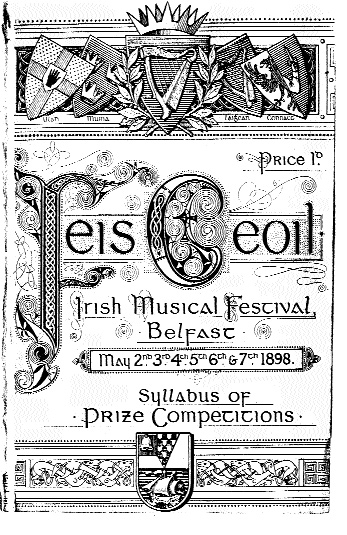
In 1880, at the age of eleven, he was enrolled in the Royal Normal School for the Blind where he remained for thirteen years, receiving a good general education and thorough training in music. One of his teachers, an extern lecturer from the Royal Academy, Frederick Corder, numbered among his pupils Granville Bantock, Arnold Bax, and Ralph Vaughan Williams. In the Methodist establishment he came, in his own words, ‘to associate religion with coppers jangling on a plate, organ-grinding of the worst kind, and eternal damnation for all poor blind devils!’ He survived the experience, getting the best of both worlds: a Catholic with a sound knowledge of the Bible.
When Carl was nineteen and still at school his father invested what at the time was a small fortune to provide for his future security; at the same time advising his blind son to make himself independent by developing his talents. Before he was twenty-three he had won diplomas as organist and pianist, still a pupil of Frederick Corder. Though also fully qualified as a teacher of music he doubted he could earn his living as a tutor. Deciding to use some of his investments to open a music store, he left London for Belfast. With a partner to run the business side of the enterprise he established himself in the northern capital. The venture failed when the money allowed by his trustees ran out, and his partner disappeared.
‘Professor of Music’
The disillusioned young man decided to remain in Belfast. Now twenty-seven, he reluctantly erected a brass plate at his residence in Limestone road: ‘Carl Gilbert von Hardebeck, Professor of Music’. He was invited to take on the job of organist and choirmaster in the church of the Holy Family, then a poor corrugated iron chapel in Newington Avenue. He later moved to St Peter’s pro-cathedral on the Falls Road where his devoted choirboys called him ‘Tantum Ergo’. For his part, demonstrating a sense of humour that stood him in good stead in his difficult life, he poked fun at the ‘holy growlers’ in the men’s confraternity, and the ‘chronic drouths’ of the Total Abstinence Society.
When the Dublin Feis Ceoil was inaugurated in 1897, he submitted an anthem in the competition for composers; God of My Salvation, for contralto and chorus, praised by a critic as ‘an uncommonly good anthem with most pleasing harmony’. The chorus had ‘the most attractive part of the work, the combination of the voices…being done with considerable skill’. He won first prize. It was apt that the first Feis Ceoil over a hundred years ago should have marked the turning point in Hardebeck’s career. During the week of the festival he heard for the first time the songs of Alfred Percival Graves and Samuel Ferguson, set to music by such establishment figures as Sir Villiers Stanford, Charles Wood, Michele Esposito and James Culwick.
In the opinion of Alice Milligan, writing in the Journal of the Irish Folksong Society, Graves was a more sensitive poet than Ferguson. Such a love-song as The Little Red Lark, ‘when sung to the exquisite air which inspired it challenged comparison with the music of Schubert wedded to the poetry of Heine’. For his part, Hardebeck heard in the songs of A.P. Graves ‘some of the finest lyrical poetry one could have for such music; the beauty and plaintiveness…enthralled me’.
Such high praise for the poetry of A.P. Graves stirs nostalgic memories for me. The legendary Hardebeck was a household name when I was growing up in Dublin. As a boy soprano my father was a member of the CBS Oxford Street choir, prize winners at the Belfast Feis in 1909. From a seemingly inexhaustible repertoire remembered from his schooldays he sang folksongs of haunting beauty now seldom heard, all set to traditional airs; most lovingly, The Little Red Lark and Ferguson’s Lark in the Clear Air.
Learnt Irish
The collections of the pioneers, and the poetry of Ferguson, James Clarence Mangan and Standish O’Grady, and the Gaelic scholar, Dr George Sigerson who had recently published his anthology, Bards of the Gael and the Gall provided a rich resource for the study of the inheritance of Irish traditional music. With the same enthusiasm Hardebeck recruited Sean Ó Catháin and Tadhg Mac a’Bhaird, native speakers, to teach him Irish; accepting the task from the conviction that without some knowledge of the language the musician would not understand the principles of Gaelic poetry, ‘essential to the proper appreciation of the music to be noted’. Never having acquired fluency in speech, he mastered the phonetic principles and understood its poetry. The realisation that here was a culture of great antiquity excited him: ‘The Irish tonalities did not originate in the Greek or Latin…the Gaelic language and poetry are at least as old as Latin or Greek’.
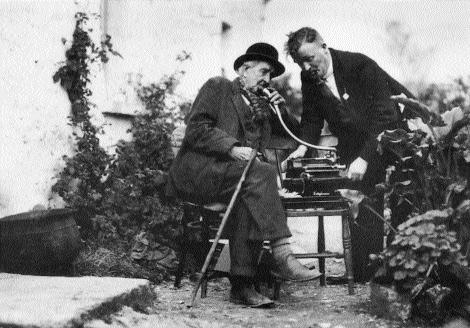
Tadhg í“ Murchíº, collector with the Irish Folklore Commission, recording on the ediphone in Spuncán, Waterville, County Kerry, c. 1936. (Roinn Bhéaloideas í‰ireann, UCD)
His admiration for the Irish speaking ‘peasant of Donegal, Cork or Mayo’ knew no bounds; the humble cottier had ‘a far higher sense of true poetry than even the average university graduate’ and a ‘more natural refinement than three-quarters of the aristocracy’. ‘Their poems voiced the feelings of the people and their history’, he wrote in the preface to Part II of Gems of Melody: A Collection of Old Irish Melodies. ‘The melodies are so beautiful, that they alone—if every other proof were wanting—show that the people who produced them must have been a highly artistic, cultured and civilised nation.’
At the Feis Cheoil in 1900 he placed himself among the traditionalists with his cantata, The Red Hand of Ulster. His conversion to an Irish idiom was confirmed at a Gaelic League concert in the Ulster Hall on St Patrick’s Day when he heard Mairtín O’Conlon, from County Clare, perform unaccompanied songs in the singer’s native Irish. ‘I was so enchanted by the flow, the rhythm, the rise and fall of melody and, above all, the simplicity and character of this music that I decided to leave all and follow it.’
Braille board and stylus
In the Donegal Gaeltacht he visited the cottage homes of Cloughanelly, Glencolumcille, Gweedore and the Rosses, collecting songs; he ‘gathered them eagerly and studied them minutely’. O’Boyle recorded a graphic description of the pioneer song collector at work, before the invention of the Dictaphone. The ‘Fear Mór Dall’ coming in on the arm of his guide, stooping low through the small door, with a Gaelic salutation on his lips. Sitting in the chimney corner, he took out his Braille board, frame and stylus, and called on the ‘singer of the household’.
In Hardebeck’s own words, taking down a traditional air was no easy task, especially from a singer when asked to repeat a phrase, had to go back to the beginning of the music and the poetry. ‘This means you have to take him up when he comes round to the phrase you want. You have to write as fast as you can to keep up with even the slowest singing pace…If you can write the words below the notes, so much the better…Without the words you have only lost time, taking down a skeleton of the tune.’
He brought to his life’s work the insights of his training and experience in the accompaniment of plain chant, and discovered that Irish melodies were composed in the same modes. ‘I found that the study of plainsong which I pursued with my friend Arthur de Meulemeester…was the greatest help to me in learning to understand the scale and principle of modal music.’
If the Gaelic League had taken up music earlier ‘the language movement would have succeeded better, because once the people understood that music, they would realise that even the music of Beethoven and Schubert did not surpass the melody of the Irish songs. Irish music was the twin sister of plain chant, and there was nothing better in church music than the Gregorian chant’. With the confidence of a scholar who had covered his ground well he strongly advised contemporaries who were not well versed in church music not to write accompaniments for Irish airs. ‘No man who does not love Gregorian music and has not the proper love, feeling and appreciation of the delicate beauty of Gregorian rhythm should tamper with Irish melodies.’
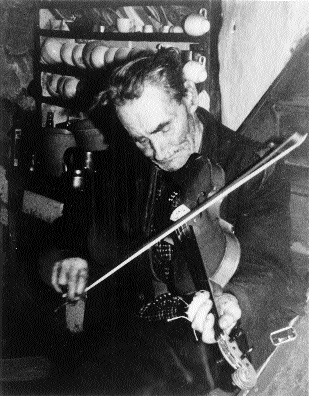
Conall Eoghain Phádraig Mac an Luain, the Bluestacks Mountains, County Donegal, c. 1972. (L. Ostberg)
Such strongly expressed views were bound to arouse hostility. He found himself isolated by the entrenched prejudice of musicians whose little world had been built on the assumption that Irish music-making, like the language, had ‘perished from the earth’. He was impatient with his contemporaries who looked to the harpers for a model for the future development of a school of Irish music and eventually ‘gave up the Feis as a bad job’.
Lineal successor to the bards
As Michael Bowles pointed out, his integrity resulted, for the first time in history, in the publication of Irish song ‘with the natural turns and graces…with the rhythms of the original language faithfully preserved, and the whole supplied with the harmonies of a qualified musician who was great enough to treat his material objectively and without conceit’. Neeson saw him as lineal successor to the bards, a direct link with the sixteenth-century Ulster musician, Rory Dall Ó Catháin and with the great Turlough Carolan himself.
When the first volume of Gems of Melody appeared in 1908, O’Boyle recalled that ‘even the enemies of traditionalism were silenced by the incomparable beauty of this work’. On the publication of the third volume in 1915 a review in the Journal of the Ivernian Society hailed the musician ‘of foreign origin’ who had become ‘more Irish than the Irish themselves’ having ‘literally fallen in love with Irish music and the Irish language’. Gems of Melody, part three, followed soon after the death of his first wife, Mary Reavy. He dedicated the work to the memory of one ‘who was a noble helpmate and inspiration to me in all my work and especially in my Gaelic work’. A poet in her own right Mary Reavy was ‘a true patriot who lived not for show, position or vainglory, but for love’s sake she lived and died’.
An Irish nationalist
O’Boyle described an extraordinary scene in St Peter’s pro-cathedral as the 1916 insurgents were surrendering in Dublin. ‘The Low Sunday congregation as they made their way out heard the organ unliturgically but exultantly pealing forth The Soldier’s Song.’ Two years later when it was proposed to appoint Hardebeck headmaster of the Cork Municipal School of Music and to the chair of Irish Music in University College Cork the choice of an Irish nationalist with a reputation for extreme views was resented by an Anglo-Irish faction in the music world of the southern capital. His new post carried a salary of £400 and a house. The house never materialised; Hardebeck had to pay for his lodgings and his income was further depleted by his need to employ a secretary. To make ends meet he was forced to play the piano in a cinema. In 1923 he returned to Belfast; a decade later, he moved to Dublin where he found rooms in Mountjoy Square.
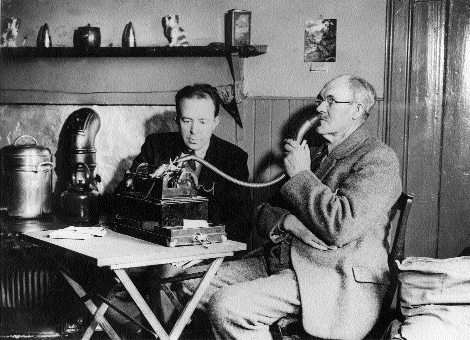
Colum Mac Gille Eathain recording Aongus MacMillan, Benbecula, Scotland, 1947.
A regular visitor, Michael Bowles, described his fellow musician in old age sitting in his drawing room all day, with his back to the window, his wireless set and his pipe and matches on a small table convenient to his hand, ‘cheerful in himself as emanating that good humour and lifting of the spirit which is natural in a strong character’. A man gifted with abilities that reached beyond the opportunities for fulfilment available in his time; in that sense, a handicap greater than his blindness.
In the evening of his life Hardebeck was accorded belated recognition with the publication of his songs by An Gúm; but he fell on hard times having earlier spent the ‘last penny’ of the money settled on him by his father in freelance ventures in the music publishing world. He confessed to Seán Neeson that he had one fear that, like so many other blind men, he might end his life begging on the streets. Hardebeck and his second wife were living largely on the charity of friends when The Capuchin Annual sponsored a Carl Hardebeck Fund, which provided a small pension. He died on Saturday 10 February 1945, mourned as a man of ‘shy disposition and amazing steadfastness of character who refused to turn his attention away from the unprofitable task he had set himself’. At a Radio Éireann symphony concert in the Capitol Theatre the following day Michael Bowles and the orchestra in an emotional tribute played Hardebeck’s own arrangement of the lullaby, Seoithín Seo.
An Irish school of music?
The growth of several vigorous schools of national music was in each case heralded by a folksong movement. In an Ireland ravaged by the Famine and in later years immersed in the politics of the Land War and the Home Rule movement, the opportunity was postponed for generations. Writing in The Capuchin Annual in 1965, Sean Neeson contemplated an Irish school. In the nineteenth century the folk-song movement on the Continent inspired Smetena and Dvorak in Czechoslovakia; Bartok and Kodaly in Hungary; Rimsky-Korsakov in Russia; de Falla in Spain; Vaughan Williams in England. In an interview in 1940 the septuagenarian Hardebeck looked to Irish composers to produce original music in an Irish idiom. Neeson saw Sean Ó Riada and Seoirse Bodley as precursors of an Irish school. Close on forty years later we may include Michael Ó Suilleabháin in their company. Today in Ireland, we honour ourselves and our own music ‘in honouring the name of Carl Gilbert Hardebeck’, a Belfast bard.
Gregory Allen is a former curator of the Gárda Museum and archivist at Gárda Headquarters.
Further reading:
C.G. Hardebeck, S. Neeson, S. O’Boyle and others, The Capuchin Annual, 1943, 1948 and 1965.
C.G. Hardebeck, ‘Traditional singing: its value and meaning’, Journal of the Ivernian Society, vol. 3 (1910).
A. Milligan, ‘Song words for Irish airs’, Journal of the Irish Folksong Society, vol. VI (1908).
P. Burke, Popular Culture in Early Modern Europe (London 1978)
This article is based on an RTÉ broadcast (2 February 1996) and is dedicated to the memory of Geoffrey Gregory Allen (1899-1965).
















